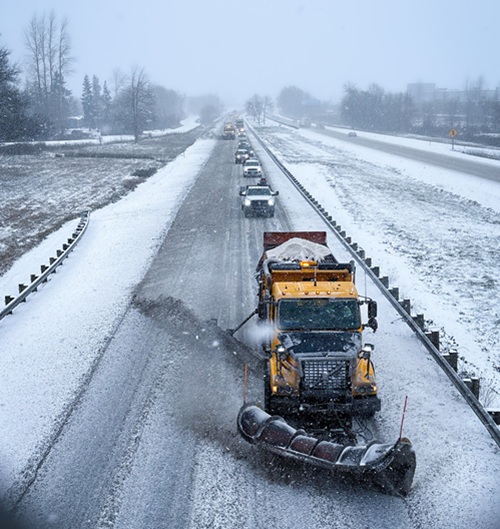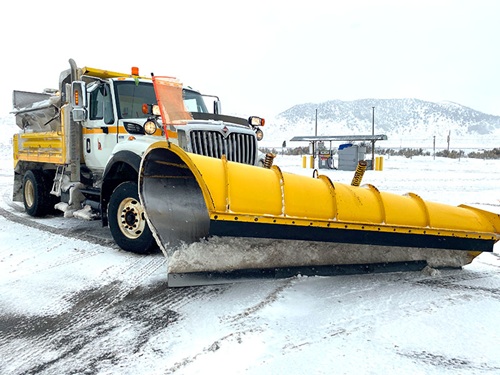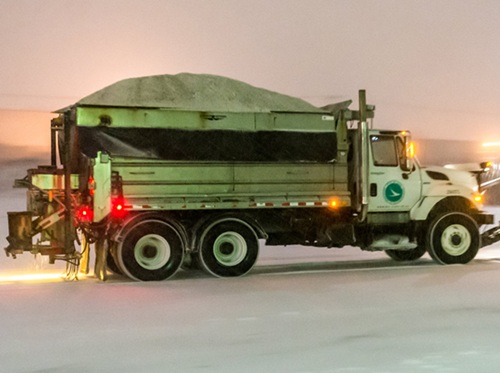Several state departments of transportation across the country are gearing up for winter; inspecting snow removal equipment, hiring seasonal employees, and engaging in outreach efforts to highlight the importance of their winter operations to the public.
[Above photo by the Ohio DOT]
The Ohio Department of Transportation, for example, uses a team of nearly 3,000 drivers who often work 12-hour shifts during snow and ice events.
While most are full-time employees, about 500 drivers are hired seasonally. In addition to full-time and seasonal drivers, the agency also uses auxiliary drivers – full-time Ohio DOT employees who normally do other tasks and only plow snow when needed.

[Editor’s note: Other state DOTs, such as the Oregon Department of Transportation and the Missouri Department of Transportation, are also busy seeking workers for snow and ice removal duties.]
Ohio DOT noted that it is responsible for more than 43,000 lane miles of state and U.S. routes outside municipalities and all interstates in Ohio, except the Ohio Turnpike, and its goal during winter storms is to have primary routes back up to speed within two hours and secondary routes within four hours of the end of a snow event – a goal its crews hit 99.3 percent of the time during the winter of 2024-2025.
[Editor’s note: Some state DOTs, such as the Colorado Department of Transportation, also handle avalanche mitigation duties during the winter as well.]
Currently, the agency said roughly 250 of its mechanics are busy conducting 150-point checks from the plow blade to the salt spinner on each of the nearly 1,700 trucks in Ohio DOT’s fleet – checks conducted now so any needed repairs can be made well before the snow starts falling and the trucks hit the road.
[Editor’s note: Other state DOTs are conducting similar equipment checks, such as the Nevada Department of Transportation as illustrated in the video below.]
For the winter of 2024-2025, Ohio DOT noted that its crews covered 9.1 million miles and deployed nearly 769,177 tons of salt and 16.4 million gallons of liquid deicers. For the 2025-2026 winter season, the agency said it already has 800,000 tons of salt on hand.
“From the mechanics in the garage to the drivers on the road, every one of our Ohio DOT employees prioritizes safety in what they do,” said Pamela Boratyn, Ohio DOT’s director, in a statement. “Our team-members and their families travel the same roads you do. We want to make sure those roads are safe for everyone to use.”
Public outreach plays another key role of winter operations for state DOTs as well; not just in terms of the importance of snow and ice removal to reinforce safe winter driving habits as well.

For example, the Idaho Transportation Department (ITD) recently kicked off its second annual ‘Name a Snowplow’ contest, which invites Idaho students to submit creative names for agency snowplows and learn about winter driving safety at the same time.
Two snowplows in each of ITD’s six regions will receive student-chosen names through voting by ITD employees. Winning names will appear directly on the plows, and each winning classroom will get a visit from “their” snowplow and driver for a winter safety presentation.
Students in grades six through 12 statewide can work with their teachers to submit name ideas throughout October, with the winning names announced by the end of the year.
“Our snowplow drivers are thrilled to see students getting involved in this fun, educational opportunity that also highlights the importance of winter driving safety,” said Scott Stokes, ITD’s director, in a statement.
 States
States
INDOT Celebrates New I-70 Welcome Center Opening
November 21, 2025 States
States

